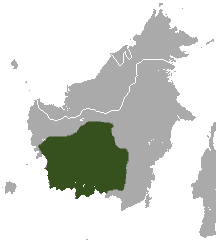User:UniversityofCincinnatiStudent/sandbox
 | This is a user sandbox of UniversityofCincinnatiStudent. You can use it for testing or practicing edits. This is not the sandbox where you should draft your assigned article for a dashboard.wikiedu.org course. To find the right sandbox for your assignment, visit your Dashboard course page and follow the Sandbox Draft link for your assigned article in the My Articles section. |
My Article to Edit:[edit]
https://en.wikipedia.org/wiki/Bornean_white-bearded_gibbon
Practice for editing purposes:
| Bornean white-bearded gibbon[1] | |
|---|---|

| |
| Scientific classification | |
| Domain: | Eukaryota |
| Kingdom: | Animalia |
| Phylum: | Chordata |
| Class: | Mammalia |
| Order: | Primates |
| Suborder: | Haplorhini |
| Infraorder: | Simiiformes |
| Family: | Hylobatidae |
| Genus: | Hylobates |
| Species: | H. albibarbis
|
| Binomial name | |
| Hylobates albibarbis Lyon, 1911
| |

| |
| Range of Bornean white-bearded gibbon (green) | |
Bornean white-bearded gibbon[edit]
The Bornean white-bearded gibbon, (Hylobates albibarbis), also known as the Bornean agile gibbon or southern gibbon, is an endangered species of gibbon endemic to southern Borneo due to the undergoing logging of the tropical forests, between the Kapuas and Barito rivers.[3] [Additional issues are of concern to the endangerment of white-bearded gibbons and threatening to other arboreal primates.][4]
The white-bearded gibbon is very similar to other gibbons in their behavior and their frugivorous diet. The Bornean white-bearded gibbon was formerly considered a subspecies of the agile gibbon but based on recent DNA research, some now classify it as a separate species.[4][5]
About[edit]
The Bornean white-bearded gibbon is commonly seen with grey or dark brown fur, a black face, and white beard. Similar to other gibbons, these gibbons are a smaller ape that is tailless. They tend to live in small family groups consisting of a male, female, and their offspring. They express pair-bonding relationships and they do not make nests. Their mode of transportation is called brachiation, where they swing from branches to get to get around. They have been documented to swing up to 15 meters in a single leap and as fast as 55 kilometers per hour. Apart from other primates, all gibbons walk bipedally; holding their long arms over their heads.[3][6]
The average life span for a white-bearded gibbon is 25 years and grow anywhere from 17 to 25 inches. Male white-bearded gibbons weigh about 6.1 to 6.9 kg and females weigh 5.5 to 6.4 kg. Female white-bearded gibbons tend to reach sexual maturity in about 48 months. [7][8]
Diet[edit]
The Bornean white-bearded gibbons diet in the tropical forest tends to be frugivorous, where they depend on the abundant of fruit trees and figs; respectfully, making their diet 65% fruit and 23% figs. They will occasionally supplement their diet with leaves and insects. [9][8]
Threats[edit]
Logging and mining have created a threatening environment in Borneo for gibbons and all arboreal creatures. Since gibbons rely on dense and tall forest areas for safety and for travelling, this is a leading problem for the survival of white-bearded gibbons. Additional threats for the white-bearded gibbon is forest fires due to global warming and climate change.[4]
References[edit]
- ^ a b Groves, C. P. (2005). Wilson, D. E.; Reeder, D. M. (eds.). Mammal Species of the World: A Taxonomic and Geographic Reference (3rd ed.). Baltimore: Johns Hopkins University Press. ISBN 0-801-88221-4. OCLC 62265494.
- ^ "Hylobates albibarbis". IUCN Red List of Threatened Species. 2008. 2008.
{{cite journal}}: Unknown parameter|assessor2=ignored (help); Unknown parameter|assessor=ignored (help); Unknown parameter|downloaded=ignored (help); Unknown parameter|last-assessor-amp=ignored (help) - ^ a b "Bornean Gibbon - Hylobates muelleri". www.ecologyasia.com. Retrieved 2018-10-21.
- ^ a b c Cheyne, S. M. (2010). "Behavioural ecology of gibbons (Hylobates albibarbis) in a degraded peat-swamp forest". In Gursky, S.; Supriatna, J. (eds.). Indonesian Primates. Developments in Primatology: Progress and Prospects. New York: Springer. pp. 121–156. doi:10.1007/978-1-4419-1560-3_8. ISBN 978-1-4419-1560-3.
- ^ Hirai, H.; Hayano, A.; Tanaka, H.; Mootnick, A. R.; Wijayanto, H.; Perwitasari-Farajallah, D. (2009). "Genetic differentiation of agile gibbons between Sumatra and Kalimantan in Indonesia". The Gibbons. pp. 37–49. doi:10.1007/978-0-387-88604-6_3. ISBN 978-0-387-88603-9.. p. 37.
- ^ "Bornean white-bearded gibbon". Project Noah. Retrieved 2018-10-21.
- ^ Cheyne, Susan M. (2010). "Behavioural Ecology of Gibbon (Hylobates albibarbis) in a Degraded Peat-Swamp Forest". https://link.springer.com/chapter/10.1007/978-1-4419-1560-3_8#Sec4_8.
{{cite journal}}: External link in|journal= - ^ a b "Gibbons | National Geographic". 2010-11-08. Retrieved 2018-10-17.
- ^ Santosa, Yanto (September 12). "Cohabitation Study of the Leaf Monkey and Bornean White-Bearded Gibbons in Gunung Palung National Park, West Kalimantan". HAYATI Journal of Biosciences. 19: 115–123.
{{cite journal}}: Check date values in:|date=(help)

